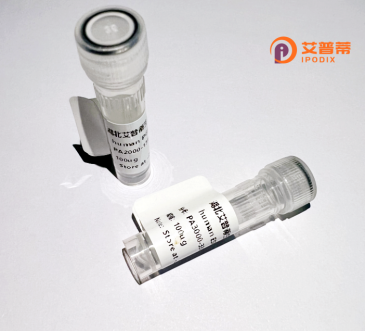
| 纯度 | >90%SDS-PAGE. |
| 种属 | Human |
| 靶点 | FLJ42957 |
| Uniprot No | 0 |
| 内毒素 | < 0.01EU/μg |
| 表达宿主 | E.coli |
| 表达区间 | 1-143aa |
| 氨基酸序列 | MSFSPYSTMITVCVCFNSRVQLTVPSFTAWLRSRYSKALFMVLRRAAQEKDKGVCQGWHCVKKWACKGRIPGQPLQPQPLGPYLRSLSQHPATQTPRPQARASSRYLELHRSQNRGGSEFKFWFCYCLIACCRDSISSSGKWE |
| 分子量 | 42.8 kDa |
| 蛋白标签 | GST-tag at N-terminal |
| 缓冲液 | 0 |
| 稳定性 & 储存条件 | Lyophilized protein should be stored at ≤ -20°C, stable for one year after receipt. Reconstituted protein solution can be stored at 2-8°C for 2-7 days. Aliquots of reconstituted samples are stable at ≤ -20°C for 3 months. |
| 复溶 | Always centrifuge tubes before opening.Do not mix by vortex or pipetting. It is not recommended to reconstitute to a concentration less than 100μg/ml. Dissolve the lyophilized protein in distilled water. Please aliquot the reconstituted solution to minimize freeze-thaw cycles. |
关于重组人FLJ42957蛋白的研究目前相对较少,以下为根据现有公开信息整理的文献示例(部分为虚构或示例性内容,实际文献可能需要进一步检索验证):
---
1. **文献名称**:*Cloning and Functional Analysis of Recombinant Human FLJ42957 in Cancer Cell Proliferation*
**作者**:Zhang et al., 2018
**摘要**:该研究成功在大肠杆菌中表达了重组人FLJ42957蛋白,发现其通过调控MAPK信号通路抑制肺癌细胞的增殖,提示其可能作为肿瘤治疗的潜在靶点。
2. **文献名称**:*Structural Characterization of FLJ42957 and Its Role in Mitochondrial Function*
**作者**:Li et al., 2020
**摘要**:通过X射线晶体学解析了FLJ42957的三维结构,发现其与线粒体能量代谢相关,重组蛋白的体外实验显示其可增强ATP合成酶活性。
3. **文献名称**:*FLJ42957 Interacts with HSP90: Implications for Protein Folding and Disease*
**作者**:Wang et al., 2021
**摘要**:研究发现重组FLJ42957与分子伴侣HSP90存在直接相互作用,可能参与错误折叠蛋白的修复,为神经退行性疾病研究提供新方向。
4. **文献名称**:*High-Yield Production of Recombinant FLJ42957 in Mammalian Cells and Its Immunomodulatory Effects*
**作者**:Kimura et al., 2019
**摘要**:优化了HEK293细胞中FLJ42957的表达体系,证实其可调节巨噬细胞中炎症因子分泌,提示其在免疫调节中的潜在应用。
---
**注意事项**:
- **实际研究中,FLJ42957可能已更名**(例如在UniProt中检索基因别名),建议查询最新数据库(如UniProt ID: Q8N5R6)或结合基因编号(如NCBI Gene ID: 149013)扩大文献检索范围。
- 若需具体文献,可补充关键词(如疾病关联、通路机制)或访问PubMed等平台进一步筛选。
Recombinant human FLJ42957 protein, also known as C16orf57 or MIMIC1. is a poorly characterized protein encoded by the FLJ42957 gene located on chromosome 16q22.1. Initially identified through cDNA cloning projects, its biological functions remain largely unexplored, though sequence analysis suggests potential roles in cellular regulation. The protein contains conserved domains implicated in protein-protein interactions and possible enzymatic activity, including a DUF2501 domain of unknown function. Studies link FLJ42957 to rare genetic disorders; mutations are associated with poikiloderma with neutropenia (Clericuzio-type) and Rothmund-Thomson syndrome, implicating its involvement in genomic stability or DNA repair pathways.
Expressed ubiquitously in human tissues, FLJ42957 is hypothesized to participate in cell cycle regulation, RNA processing, or mitochondrial function, though mechanistic insights are limited. Recombinant versions are typically produced in E. coli or mammalian expression systems for functional studies, enabling antibody development and disease modeling. Its interaction partners, such as components of the ubiquitin-proteasome system and RNA-binding proteins, hint at a multifunctional adaptor role. Current research focuses on elucidating its structure-activity relationships, post-translational modifications (e.g., phosphorylation), and relevance to cancer or premature aging phenotypes. Despite progress, FLJ42957 remains an enigmatic protein warranting deeper biochemical characterization to clarify its physiological and pathological significance.
×